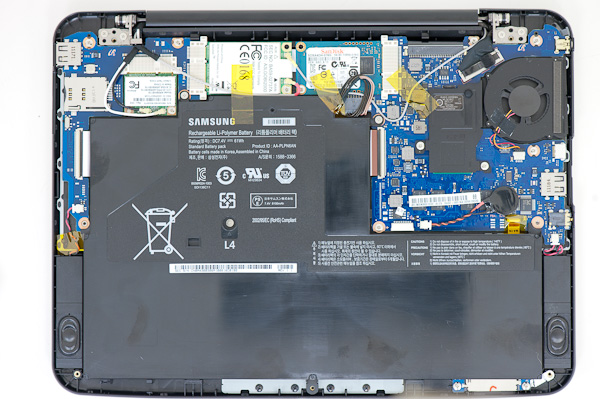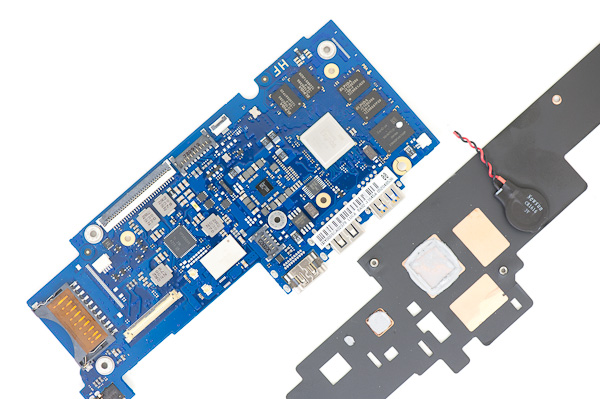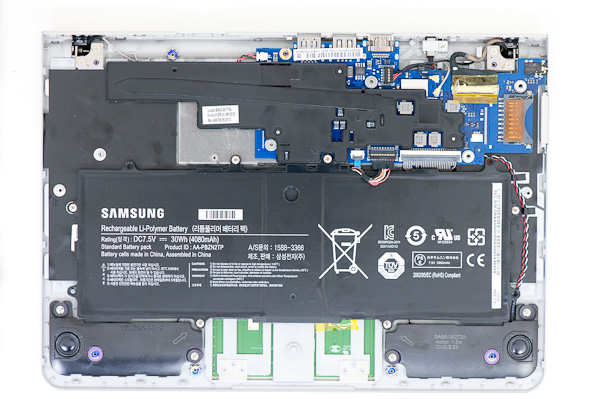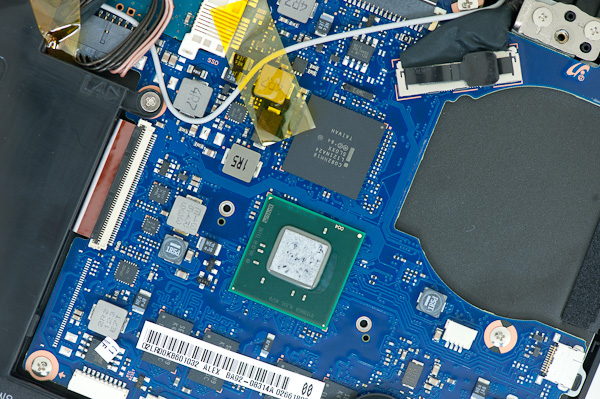Samsung Chromebook (XE303) Review: Testing ARM's Cortex A15
by Anand Lal Shimpi on October 31, 2012 9:00 AM ESTInside the new Chromebook
Similar to its predecessors, getting access to the internals of the new Chromebook doesn't require anything more than a tiny Phillips head screwdriver. There are four exposed screws and four more under the feet beneath the chassis. Remove all eight screws and you can pry off the bottom cover. The cover snaps into place so be careful if/when you remove it.
Inside the new Chromebook is a far more simplified setup. It honestly looks more like a modern day tablet under the hood. I never got the Celeron based Chromebook 550, but I do have the 500 which featured a dual-core Atom N570 processor. Here's a shot of that model for comparison:

The old Atom N570 based Chromebook
Right off the bat you'll notice a significant reduction in battery capacity. That old N570 based Chromebook had a mammoth 61Wh battery compared to the more tablet-sized 30Wh battery in the new model.
The old motherboard was also far less integrated. Discrete cards were used to provide cellular and WiFi connectivity, whereas the new board integrates WiFi (Marvell?) directly onto the motherboard.
The cost reduction extends to the SoC side as well. Intel charges $86 for an Atom N570, while the going rate for high-end ARM based SoCs is in the $20 - $30 range (and this is why ARM is the new AMD when it comes to keeping Intel pricing in check). I also suspect that this first run of Samsung Exynos 5 Dual chips are a bit leakier and perhaps even lower yielding than what we'll eventually see down the road. Samsung could be motivated to move these parts at a better cost structure as they work out kinks in manufacturing.
Note that the previous Atom solution required two chips: the N570 and its NM10 Express PCH. The N570 had a 2.1W TDP and was used for all IO, while the N570 and its two Atom cores needed about 8.5W. The combination was fine for a notebook but when Haswell can deliver much better performance within the same TDP, it's clear the old 45nm CPU + chipset were getting long in the tooth.

The far simplified, single-chip Samsung Exynos 5 Dual solution
Despite the absence of any significant heatsink, to remove 10.6W of heat you do need forced air convection hence the inclusion of a fan in the old Chromebook 500. The thermal requirements of the Exynos 5 Dual are significantly lower. The SoC benefits from Samsung's 32nm HK+MG LP process and is highly integrated, meaning there's only a single chip. Although there's a big heatspreader plate complete with heatpipe that runs over the Exynos 5, there's no fan needed. Removing the fan lowers build cost, reduces internal complexity, and helped Samsung shrink the chassis size.
There are a total of 8 x 256MB DDR3L devices (2GB total) that surround the Exynos 5 Dual SoC (4 on each side of the PCB). Each device is 8-bits wide, all connecting up to the 64-bit wide DDR3L memory controller. The DRAM is clocked at a 1600MHz data rate, resulting in 12.8GB/s of memory bandwidth to the chip. The Exynos 5 Dual integrates two ARM Cortex A15 CPU cores as well as an ARM Mali-T604 GPU.

The other big change on the motherboard is the move from a SanDisk discrete controller + NAND device to an integrated iNAND solution for storage. Capacity remains unchanged at 16GB, but the integrated eMMC controller does offer board (and perhaps cost) savings.
Moving to a lower power SoC not only gave Samsung some flexiblity in cooling, it also allowed it to run the platform with a much smaller battery. While the old Chromebook 500 used a massive 61Wh battery, the new model only needs a 30Wh unit. Battery life has gone down (Exynos 5 Dual isn't 2x more power efficient than the 45nm Atom N570) but so has weight as well. I believe the Chromebook 550 ditched the giant battery and moved to a ~40Wh unit, so the difference isn't as drastic there.




















149 Comments
View All Comments
superflex - Wednesday, October 31, 2012 - link
Way to use the crappiest pictures of the display you could wrestle up.If the display is on par with other 768 TN panels used in laptops reviewed by AT, why did you use those washed out pictures of the display? I don't see the same lack of photography skills when reviewing other laptops with similar panels.
I guess since Google isn't stroking AT the same way Apple does, a fair review with fair pictures would be pointless.
Hacks!
PsychoPif - Wednesday, October 31, 2012 - link
Why would you base your opinion on a picture when they provide numerics to back up the review?Since I learned about Photoshop, I no longuer believe what I see on a picture anyway.
superflex - Wednesday, October 31, 2012 - link
Ever hear the phrase "A picture says a thousand words"?For the casual viewer, who may not delve into the display numbers, the pictures certainly do tell a story. It just depends on what story AT wants to tell.
superflex - Wednesday, October 31, 2012 - link
Look at the review of the Dell XPS 14Z. According to the numbers in this review, the panel in the Sammy CB is on par, if not better than the one used by Dell. Look at the pictures of the Dell display vs the CB display. Are they on par with one another?You can certainly influence a consumers purchasing decision based on some sub-par photographs.
Well done AT.
PeteH - Wednesday, October 31, 2012 - link
Do you really think the people technologically sophisticated enough to be interested in an AnandTech review are the same people who would base their purchasing decision on one photograph of a display?superflex - Wednesday, October 31, 2012 - link
Do you really think nobody will do a Google search for "Samsung Chromebook Review" and find AT's site on the list?I guess Google is smart enough to know a persons IQ and direct them away from AT and its "sophisticated" readers.
Sheeesh, get over yourself.
PeteH - Wednesday, October 31, 2012 - link
Seriously? Just start reading the review, it is clearly not targeted at consumers. Heck, there's a photo of a circuit board on the first page! There's a tear down of the device (complete with photos) before the display is even discussed! Who is going to read this review other than people who care deeply about the technical aspects of the Chromebook?But I'm starting to think you know that, and the real reason you're upset is because AnandTech pointed out that the Chromebook has a crappy display.
SND_ - Wednesday, October 31, 2012 - link
Most likely the Chromebook doesn't have a very good display AND the picture sucks.I did notice that the display looks very poor in that image. I doubt it's that bad (two feet in front of you). . . typing "Chromebook" into Google will fetch you better pictures of suggesting a display of higher quality.
LogOver - Wednesday, October 31, 2012 - link
I would like to see a comparison with the Celeron-based Chromebookkrumme - Wednesday, October 31, 2012 - link
Celleron is a different price segment.The comparison was perfect and valid imho.